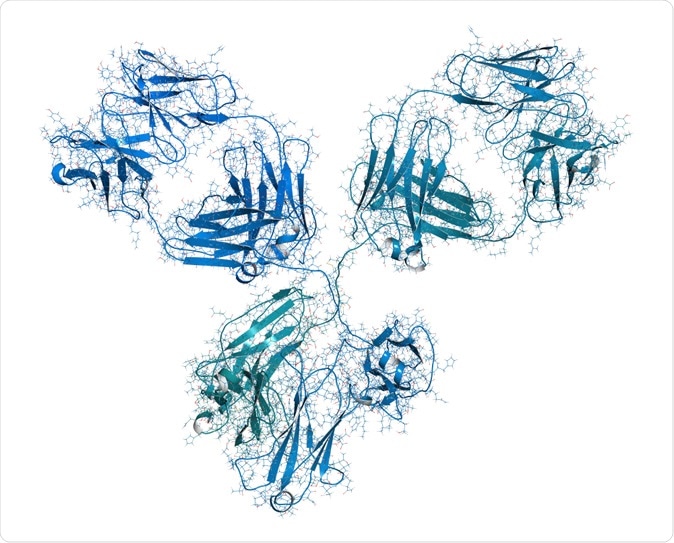The performance of commercially available serological tests in real patient samples and the correlates of immunity to severe acute respiratory syndrome coronavirus 2 (SARS-CoV-2) provided by IgG antibodies are still a matter of debate. A new bioRxiv preprint paper cross-examines the performance of several assays and proclaims the plaque reduction neutralization test (PRNT) as a method of choice.

IgG1 monoclonal antibody (immunoglobulin). 3D rendering based on protein data bank entry 1igy. Image Credit: StudioMolekuul / Shutterstock
Coronavirus disease 2019 (COVID-19) pandemic caused by SARS-CoV-2 has prompted rapid developments in diagnostic technologies. Currently, there are no vaccines or drugs available, so there are talks about using convalescent plasma for treatment purposes.
Nucleic acid amplification testing (such as polymerase chain reaction or PCR) represents the method of choice in the early phases of infection.
If convalescent plasma is used for these purposes, sensitive and especially highly specific antibody assays are needed. As the spectrum of clinical SARS-CoV-2 signs are very broad, and asymptomatic infections are reported, to acquire knowledge about the seroprevalence of SARS-CoV-2 and to test for (potential) individual immunity, there is an increasing demand in the detection of antibodies, especially of IgG antibodies.
Also, there is a need to detect past infection to find correlates of immune protection adequately. This is why researchers from the Institute for Medical Virology at Goethe University Hospital and German Centre for Infection Research in Frankfurt, Germany, decided to appraise available serological tests in depth.
"To acquire knowledge about the seroprevalence of SARS-CoV-2 and to test for (potential) individual immunity, there is an increasing demand in the detection of antibodies – especially of IgG antibodies", they state in their paper.
Viral potpourri for performance gauging
The researchers collected follow up plasma or serum samples from a total of 69 individuals with PCR-diagnosed SARS-CoV-2 infection at different time points. Most of the samples were taken from patients with moderate to severe illness who needed an in-patient hospital stay.
The samples of individuals infected with endemic human coronavirus, cytomegalovirus, and Epstein-Barr virus were used to appraise potential cross-reactivity and the risk of false-positive results. Additionally, follow up samples of patients infected with the original SARS-CoV in the 2003 outbreak were also used.
By focusing on IgG antibodies, the performance of diagnostic tests was analyzed for lateral flow assay (The FasStep rapid test cassettes), ELISA or enzyme-linked immunosorbent assays (Euroimmun SARS-CoV-2 IgG ELISA and Vircell COVID-19 ELISA IgG), immunofluorescence assay (IFA) and PRNT.
The main performance outcomes were sensitivity (the ability of an assay to identify patients with COVID-19 antibodies correctly) and specificity (the ability of an assay to identify those without the antibodies correctly).
Test sensitivity/specificity in real-life conditions
In the early phase of infection (i.e., between 5 and 9 days after PCR-confirmed infection), the in-house developed IFA and PRNT showed a sensitivity of 76.5%, the Vircell ELISA a sensitivity of 70.6%, the Assure Tech Rapid Test sensitivity of 62.5%, and the Euroimmun ELISA a sensitivity of 58.8%.
These percentages increased to more than 90% for the subsequent infection period (i.e., from days 10-18), reaching 100% when Vircell ELISA, in-house IFA, and Assure Tech tests were used. Specificity results for Vircell ELISA, in-house IFA, and Euroimmun ELISA were 83.3%, 86.4%, and 96.2%, respectively.
Practically all samples tested positive in commercially available assays showed neutralizing properties in the PRNT (with titers higher than 1:20), stipulating a potential protective immunity.
This is important, as some researchers caution about large-scale antibody testing for policy development until we understand the exact proportion of COVID-19 patients with neutralizing antibodies.
Consistency and practical considerations
In terms of sensitivity, the data obtained by the research group from Germany are consistent with previously published findings. One problem is that the titer needed for potential protective immunity is still not officially defined. Also, there is evidence that T-cell-mediated immunity plays a role in COVID-19 (alongside humoral immunity).
The advantage of lateral flow assays is that they can be utilized by less experienced personnel in a point-of-care setting, providing results in a relatively short time frame. Nonetheless, the correlates of viral infection can be detected in some samples only by using IFA and PRNT as a gold standard.
Concluding remarks
Although cross-reactivity was observed with SARS-CoV samples from the SARS outbreak in 2003 with IFA and Vircell ELISA, this is of lesser importance since this virus is eradicated. Nevertheless, additional efforts should be made to enhance the specificity of the available assays further, as any false positive result provides a false sense of security.
"All in our study examined assays are eligible for the detection of SARS-CoV-2 IgG antibodies, indicating a potential protective immunity", emphasize study authors in their paper.
"Ideally, to get the maximum sensitivity, testing should be performed in the later phase of infection (≥ 10 days) after PCR-confirmation or disease onset of COVID-19", they add.
This study showed that IFA, Vircell ELISA, and PRNT had the highest sensitivity among our diagnostic armamentarium. Still, the PRNT is currently still the method of choice for debates regarding potential SARS-CoV-2 immunity; therefore, it should be performed when available.

 This news article was a review of a preliminary scientific report that had not undergone peer-review at the time of publication. Since its initial publication, the scientific report has now been peer reviewed and accepted for publication in a Scientific Journal. Links to the preliminary and peer-reviewed reports are available in the Sources section at the bottom of this article. View Sources
This news article was a review of a preliminary scientific report that had not undergone peer-review at the time of publication. Since its initial publication, the scientific report has now been peer reviewed and accepted for publication in a Scientific Journal. Links to the preliminary and peer-reviewed reports are available in the Sources section at the bottom of this article. View Sources